Kandiyohi County, Minnesota
Kandiyohi County (/kændiːˈjoʊhaɪ/ kan-dee-YOH-hy) is a county in the U.S. state of Minnesota. As of the 2010 United States Census, its population is 42,239.[2] As of November 20, 1871, its county seat is Willmar.[3]
Kandiyohi County | |
|---|---|
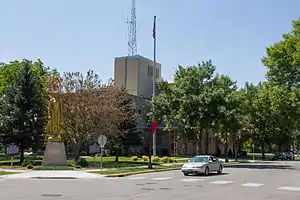 Kandiyohi County Courthouse | |
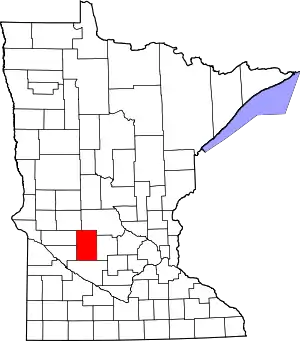 Location within the U.S. state of Minnesota | |
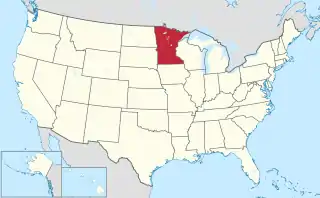 Minnesota's location within the U.S. | |
| Coordinates: 45°09′N 95°01′W | |
| Country | |
| State | |
| Founded | March 20, 1858[1] |
| Named for | "where buffalo fish come" (Dakota) |
| Seat | Willmar |
| Largest city | Willmar |
| Area | |
| • Total | 862 sq mi (2,230 km2) |
| • Land | 797 sq mi (2,060 km2) |
| • Water | 66 sq mi (170 km2) 7.6%% |
| Population (2010) | |
| • Total | 42,239 |
| • Estimate (2019) | 43,199 |
| • Density | 53.6/sq mi (20.7/km2) |
| Time zone | UTC−6 (Central) |
| • Summer (DST) | UTC−5 (CDT) |
| Congressional district | 7th |
| Website | www |
Kandiyohi County comprises the US Census Bureau's "Willmar, MN Micropolitan Statistical Area".
History
Kandiyohi County is named for a Dakota word meaning "where the buffalo fish come".[4] (kandi’ - the buffalo fish + oh-hi’-yu - v. of hiyu - to come through).[5] It was organized on March 20, 1858, with Kandiyohi established as the county seat in 1870 (it was then called Kandiyohi Station, as it was merely a stop on the railroad line). The original county occupied only the southern half of its current area. Development was slow, and in 1870 the state legislature called for Monongalia County to merge with Kandiyohi. It took until November 21, 1871 to agree on the centrally located Willmar as the county seat.
Geography
The terrain of Kandiyohi County consists of rolling hills, partly wooded, mostly devoted to agriculture.[6] The territory slopes to the south and west, with the highest point near its northeastern corner, at 1,306' (398m) ASL.[7] The county has a total area of 862 square miles (2,230 km2), of which 797 square miles (2,060 km2) are land and 66 square miles (170 km2) (7.6%) are covered by water.[8] Kandiyohi County is one of seven southern Minnesota counties that have no forest soils; only prairie ecosystems of savannas and prairies exist.

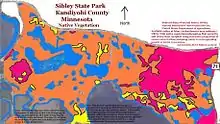
Lakes[6]
- Bass Lake
- Bear Lake
- Big Kandiyohi Lake
- Burr Oak Lake
- Calhoun Lake
- Cherry Lake
- Church Lake
- Crook Lake
- Diamond Lake
- Dog Lake
- Downs Lake
- Eagle Lake
- East Solomon Lake
- East Sunburg Lake
- Elkhorn Lake
- Ella Lake
- Emma Lake
- Florida Lake
- Foot Lake
- Games Lake
- George Lake
- Ging Lake
- Green Lake
- Hefta Lake
- Henchien Lake
- Henderson Lake
- Henium Lake
- Hubbard Lake
- Johnson Lake
- Knutsons Lake
- Lake Andrew
- Lake Carrie
- Lake Eight
- Lake Eleanor
- Lake Elizabeth
- Lake Kasota
- Lake Lillian
- Lake Minnetaga
- Lindgren Lake
- Little Kandiyohi Lake
- Long Lake (Dovre Township)
- Long Lake: (Irving and Roseville townships)
- Mamre Lake
- Mary Lake
- Middle Lake
- Mud Lake
- Nest Lake
- Norstedt Lake
- Norway Lake
- Olson Lake
- Otter Lake
- Point Lake
- Prairie Lake
- Ringo Lake
- Saint Johns Lake
- Schultz Lake
- Shoemaker Lake
- Skataas Lake
- Skull Lake
- Sperry Lake
- Stevens Lake
- Summit Lake
- Swan Lake (Colfax and Lake Andrew townships)
- Swan Lake: (Dovre and Willmar townships)
- Swan Lake: (Kandiyohi Township)
- Swan Lake: (Mamre Township)
- Swenson Lake
- Taits Lake
- Thompson Lake
- Timber Lake
- Twin Lakes
- Wagonga Lake
- West Solomon Lake
- West Sunburg Lake (part)
- Wheeler Lake
- Willmar Lake
- Woodcock Lake (Green Lake Township)
- Woodcock Lake: (New London and Green Lake townships)
Major highways
Adjacent counties
- Stearns County (north)
- Meeker County (east)
- Renville County (south)
- Chippewa County (southwest)
- Swift County (west)
- Pope County (northwest)
Protected areas[6]
- Burbank State Wildlife Management Area
- Dietrich Lange State Wildlife Management Area
- Oleander State Wildlife Management Area
- Ringo-Nest State Wildlife Management Area
- Roseville State Wildlife Management Area
- Sibley State Park
- Sunburg State Wildlife Management Area
- Yohi State Wildlife Management Area
Demographics
| Historical population | |||
|---|---|---|---|
| Census | Pop. | %± | |
| 1860 | 76 | — | |
| 1870 | 1,760 | 2,215.8% | |
| 1880 | 10,159 | 477.2% | |
| 1890 | 13,997 | 37.8% | |
| 1900 | 18,416 | 31.6% | |
| 1910 | 18,969 | 3.0% | |
| 1920 | 22,060 | 16.3% | |
| 1930 | 23,574 | 6.9% | |
| 1940 | 26,524 | 12.5% | |
| 1950 | 28,644 | 8.0% | |
| 1960 | 29,987 | 4.7% | |
| 1970 | 30,548 | 1.9% | |
| 1980 | 36,763 | 20.3% | |
| 1990 | 38,761 | 5.4% | |
| 2000 | 41,203 | 6.3% | |
| 2010 | 42,239 | 2.5% | |
| 2019 (est.) | 43,199 | [10] | 2.3% |
| US Decennial Census[11] 1790-1960[12] 1900-1990[13] 1990-2000[14] 2010-2019[2] | |||
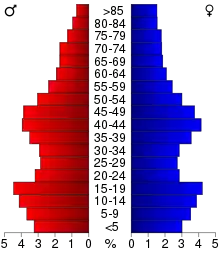
2000 census
As of the 2000 United States Census, there were 41,203 people, 15,936 households, and 10,979 families residing in the county. The population density was 51.7/sqmi (20.0/km2). There were 18,415 housing units at an average density of 23.1/sqmi (8.92/km2). The racial makeup of the county was 93.62% White, 0.51% Black or African American, 0.33% Native American, 0.38% Asian, 0.07% Pacific Islander, 4.17% from other races, and 0.91% from two or more races. 8.00% of the population were Hispanic or Latino of any race. 31.4% were of German, 25.8% Norwegian, 9.9% Swedish and 5.6% Dutch ancestry.
There were 15,936 households, out of which 33.10% had children under the age of 18 living with them, 57.70% were married couples living together, 7.50% had a female householder with no husband present, and 31.10% were non-families. 25.70% of all households were made up of individuals, and 10.80% had someone living alone who was 65 years of age or older. The average household size was 2.53 and the average family size was 3.05.
The county population contained 26.60% under the age of 18, 9.50% from 18 to 24, 26.50% from 25 to 44, 22.50% from 45 to 64, and 14.90% who were 65 years of age or older. The median age was 37 years. For every 100 females there were 98.00 males. For every 100 females age 18 and over, there were 94.90 males.
The median income for a household in the county was $39,772, and the median income for a family was $48,016. Males had a median income of $32,272 versus $22,128 for females. The per capita income for the county was $19,627. About 5.90% of families and 9.20% of the population were below the poverty line, including 11.10% of those under age 18 and 7.90% of those age 65 or over.
Communities
Cities
Unincorporated communities
Townships
- Arctander Township
- Burbank Township
- Colfax Township
- Dovre Township
- East Lake Lillian Township
- Edwards Township
- Fahlun Township
- Gennessee Township
- Green Lake Township
- Harrison Township
- Holland Township
- Irving Township
- Kandiyohi Township
- Lake Andrew Township
- Lake Elizabeth Township
- Lake Lillian Township
- Mamre Township
- New London Township
- Norway Lake Township
- Roseland Township
- Roseville Township
- St. Johns Township
- Whitefield Township
- Willmar Township
Politics
Kandiyohi County voters have switched from Democratic to Republican in recent years. In no national election since 1996 has the county selected the Democratic Party candidate (as of 2016). However, incumbent Democratic-Farmer-Labor Senator Amy Klobuchar won the county in 2018 as she coasted to an easy reelection over Republican challenger Jim Newberger. Klobuchar also carried Kandiyohi county in her 2006 and 2012 victories.
| Year | Republican | Democratic | Third parties |
|---|---|---|---|
| 2016 | 58.7% 12,785 | 33.4% 7,266 | 7.9% 1,721 |
| 2012 | 52.4% 11,240 | 45.7% 9,805 | 2.0% 420 |
| 2008 | 51.7% 11,319 | 46.2% 10,125 | 2.1% 451 |
| 2004 | 54.8% 11,704 | 43.7% 9,337 | 1.4% 308 |
| 2000 | 52.0% 10,026 | 42.6% 8,220 | 5.4% 1,039 |
| 1996 | 38.4% 7,119 | 48.6% 9,009 | 13.0% 2,404 |
| 1992 | 34.5% 6,784 | 40.3% 7,914 | 25.2% 4,958 |
| 1988 | 48.3% 8,634 | 50.2% 8,962 | 1.5% 266 |
| 1984 | 52.7% 9,539 | 46.4% 8,402 | 0.9% 163 |
| 1980 | 46.9% 8,480 | 44.4% 8,038 | 8.7% 1,577 |
| 1976 | 38.9% 6,664 | 58.3% 9,992 | 2.8% 474 |
| 1972 | 45.7% 6,624 | 50.0% 7,241 | 4.3% 616 |
| 1968 | 38.0% 5,086 | 57.0% 7,639 | 5.0% 675 |
| 1964 | 30.5% 4,011 | 69.2% 9,108 | 0.3% 37 |
| 1960 | 50.0% 6,786 | 49.7% 6,738 | 0.3% 43 |
| 1956 | 44.3% 5,445 | 55.5% 6,834 | 0.2% 26 |
| 1952 | 50.0% 6,370 | 49.1% 6,264 | 0.9% 113 |
| 1948 | 31.6% 3,666 | 62.1% 7,204 | 6.2% 723 |
| 1944 | 36.6% 3,784 | 62.6% 6,482 | 0.8% 87 |
| 1940 | 36.9% 4,263 | 62.3% 7,187 | 0.8% 90 |
| 1936 | 26.3% 2,500 | 69.3% 6,595 | 4.5% 429 |
| 1932 | 30.0% 2,674 | 65.3% 5,813 | 4.7% 414 |
| 1928 | 67.8% 5,780 | 29.1% 2,481 | 3.1% 261 |
| 1924 | 40.2% 3,222 | 2.8% 222 | 57.1% 4,578 |
| 1920 | 63.7% 4,759 | 17.2% 1,282 | 19.2% 1,433 |
| 1916 | 41.8% 1,612 | 51.1% 1,968 | 7.1% 275 |
| 1912 | 14.6% 484 | 25.8% 855 | 59.6% 1,979 |
| 1908 | 63.6% 2,312 | 26.1% 947 | 10.3% 375 |
| 1904 | 81.3% 2,576 | 8.0% 252 | 10.8% 342 |
| 1900 | 64.3% 2,343 | 33.1% 1,204 | 2.6% 96 |
| 1896 | 56.3% 2,181 | 42.3% 1,638 | 1.5% 58 |
| 1892 | 50.9% 1,341 | 14.9% 391 | 34.2% 901 |
See also
- Kandiyohi County Historical Society
- National Register of Historic Places listings in Kandiyohi County, Minnesota
- Category:People from Willmar, Minnesota
References
- "Minnesota Place Names". Minnesota Historical Society. Archived from the original on June 20, 2012. Retrieved March 18, 2014.
- "State & County QuickFacts". United States Census Bureau. Archived from the original on June 7, 2011. Retrieved September 1, 2013.
- "Find a County". National Association of Counties. Archived from the original on May 31, 2011. Retrieved June 7, 2011.
- Gannett, Henry (1905). The Origin of Certain Place Names in the United States. Govt. Print. Off. pp. 172.
-
- Riggs, Stephen (1890). Dakota-English Dictionary (1892 ed.). Minnesota Historical Society Press. Retrieved July 11, 2016.
- Bonde, Thomas J. H. (November 1996). "Buffalo Fish (the Real Thing) Is Special Acquisition" (PDF). The Minnesota History Interpreter. XXIV (11): 1. Retrieved July 11, 2016.
- Kandiyohi County MN Google Maps (accessed 14 March 2019)
- ""Find an Altitude/Kandiyohi County MN" Google Maps (accessed 14 March 2019)". Archived from the original on May 21, 2019. Retrieved March 14, 2019.
- "2010 Census Gazetteer Files". US Census Bureau. August 22, 2012. Archived from the original on September 21, 2013. Retrieved October 18, 2014.
- Nelson, Steven (2011). Savanna Soils of Minnesota. Minnesota:Self. pp. 49-52. ISBN 978-0-615-50320-2.
- "Population and Housing Unit Estimates". Retrieved March 26, 2020.
- "US Decennial Census". US Census Bureau. Archived from the original on April 26, 2015. Retrieved October 18, 2014.
- "Historical Census Browser". University of Virginia Library. Retrieved October 18, 2014.
- "Population of Counties by Decennial Census: 1900 to 1990". US Census Bureau. Retrieved October 18, 2014.
- "Census 2000 PHC-T-4. Ranking Tables for Counties: 1990 and 2000" (PDF). US Census Bureau. Retrieved October 18, 2014.
- Leip, David. "Atlas of US Presidential Elections". uselectionatlas.org. Retrieved April 7, 2018.
